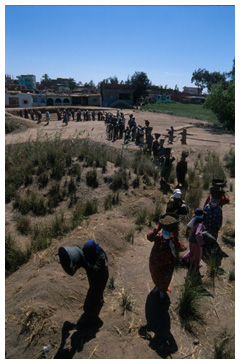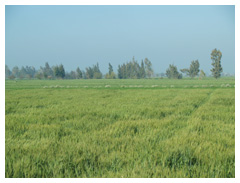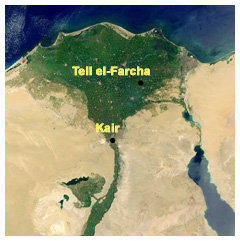



|
Tell el-Farkha archaeological site
Tell el-Farkha is an important site in the eastern Nile delta. It is composed of 3 koms, lying at the edge of the village of Ghazala about 120 km to the northeast of Cairo. The mounds rise about 5 m above surrounding fields, occupying an area of more than 4 ha.
The excavations from the beginning are an interdisciplinary project. Besides archaeologists in our work take part: ceramologists, physical anthropologists, osteologists, geologists, paleobotanists and geophysics.
The site of Tell el-Farkha was identified in 1987 as a survey result carried out by the Italian archaeological mission of Centro Studi e Reserche Ligabue in Venice. The surveyed area covered over 100 ha where over 30 archaeological sites were found. One of the sites chosen for excavations was Tell el-Farkha. Archaeological works headed by R. Fattovich brought in 1988-1990 no spectacular results. Small test trenches revealed pottery and architectural remains that enabled the chronological site sequence to be established from the Lower Egyptian culture to the beginnings of the Old Kingdom times. After two years, financial reasons forced the Italian mission to abandon the site. In 1998 the research were resumed by Polish archaeologists. The change of exploration methods into the wide surface one resulted in the discovery of architectural layout of the ancient settlement.
The importance of the site for a new understanding of the processes leading to the emergence of Pharaonic civilization left no doubt practically from the first season. The early art and architecture of ancient Egypt offers little in the way of parallels for both buildings and finds, and the discoveries of the last few seasons are truly unprecedented. Interest has been worldwide in a deposit of figurines of unmatched artisanship, crafted of hippo tusks, and golden-sheet figures depicting a Predynastic ruler and his son and heir, which are the oldest known from Egypt.
The thousand-year history of the site, started many hundreds of years before the emergence of the pharaohs' state and clearly divided into several phases. The oldest period is connected with the Lower Egyptian Culture of the autochthonous inhabitants of the Delta, who inhabited the settlement at Tell el-Farkha from c. 3600 to c. 3300 BC. They were followed by settlers from the south, Naqadians or to be more precise men associated with the first political centres emerging in Upper Egypt at the time. The apogee of development came in Protodynastic times and during the rule of Dynasties 0 and I (c. 3200 BC - 2950 BC). A slump occurred about the middle of the First Dynasty, but settlement continued off and on into the early Fourth Dynasty (Old Kingdom, c. 2600 BC).

In the Western part of the site the oldest levels have revealed large domestic structures, not recorded previously in Egypt, constructed of posts and wattle-and-daub walls. Of much greater importance in terms of features connected with the Lower Egyptian Culture horizon were the remains of the oldest (c. 3500 BC - 3350 BC) complex of breweries. Five of them were excavated; at least two others are still waiting for exploration.
The first Naqadians which had settled at Tell el-Farkha erected a huge building on top of the forgotten breweries. Till now only eastern part of these building was excavated. The western part should be explored in the next season. However it is the biggest complex known in Egypt from the period c. 3300 BC - 3200 BC. The objects found inside it are proof of the role of trade in the life of the inhabitants. The building may have been a residence connected with stores, belonging to a Naqadian official from the south of Egypt charged with control over the trade between Palestine and the Delta on one hand and Upper Egypt on the other. He would have been associated with one of the early Egyptian rulers residing in Abydos or Hierakonpolis, whose rule extended over all or a considerable part of Egypt.
Another monumental complex was discovered on top of the mentioned building, again consisting of several chambers separated by walls of varying thickness. Votive deposits were found in two of the rooms. Especially important is the deposit found in 2006. Figurines crafted of hippo tusks, which were equally precious as ivory, depicted men, women, fantastic creatures and animals, models of various objects made of stone, faience and bone, and miniature vessels of stone. More unique figurines, many of which have never before been recorded for such early periods in Egypt's history, were discovered in 2007. Now these objects are exhibited in the Cairo Museum.
The importance of Tell el-Farkha as an administrative and cult centre has thus been confirmed and there is hope that further investigations will answer the question which deity was worshipped here.
In the same 2006 year in Eastern part of site we found a few dozen pieces of gold sheet accompanied by a hoard of ostrich-eggshell and carnelian beads and two large and perfectly crafted flint knives, 30 and 50 cm long respectively, undoubtedly of ritual function. This deposit proved to be a hundred years older than the origins of the first Egyptian state. Judging by the archaeological context of the deposit, it must have been hidden away here, possibly in fear of an approaching invasion. Once cleaned and studied, the gold fragments turned out to be the precious sheeting of two naked figures of standing men (60 and 30 cm high), likely representing an early ruler and his young progeny and heir. They are the oldest sculpture (in these type) found till now in Egypt, and now they are also exhibited in the Cairo Museum.
The Eastern part of the site is also a cemetery. So far we explored 108 graves - many others were discovered and should be excavated in the next seasons. The most important graves found at Tell el-Farkha are early mastabas, dated to the Dynasty 0 and I. The richest of the burials in terms of grave goods included up to 70 clay vessels, up to 35 stone vessels, ornaments of semi-precious stones and gold, clay figurines, cosmetic palettes, models of granaries, tools and weapons. Many of the vessels bore so called pot marks which are in essence the oldest known hieroglyphic signs presumably intended as a means of identifying the origins of a pot or the export destination of the goods inside it. The names of two successive rulers of Dynasty 0, Iry-Hor and Ka, and that of king Narmer of Dynasty I have been deciphered among the signs. In last season we found the names of two unknown till now kings from the Dynasty 0.
Last but not least, we are dealing (in the central part of the site) with ordinary settlement of farmers, herders, fishermen and artisans, subordinated to the elites residing on the western mound. Even so, the jewellery found here, the copper artefacts, imported pottery and seals and impressions of seals leave little doubt regarding the affluence of this population and their avid participation in long-range trade.
Looking back at 12 seasons of work at the site, one cannot but perceive the site's uniqueness. The zonal division into the residential and cultic complex on the Western Kom, the domestic and economic quarter on the central mound and the cemetery and settlement on the eastern one has provided an exceptional opportunity to trace the origins, rise and fall of an important administrative centre existing at the time of the emergence of the pharaoh's state.
|
|